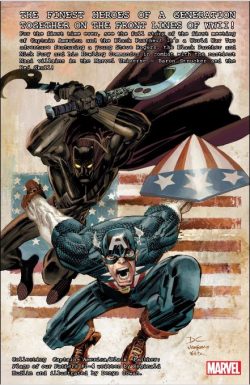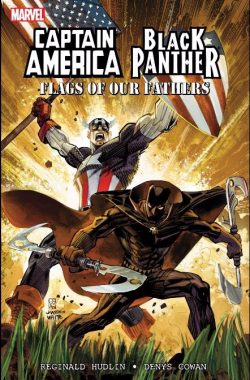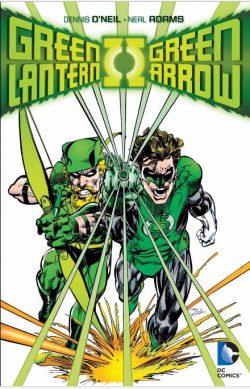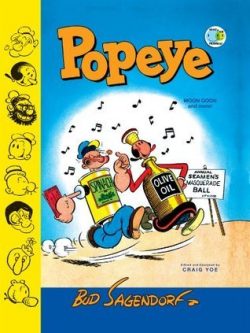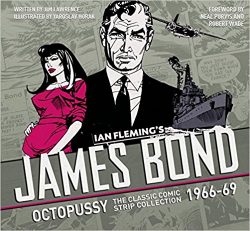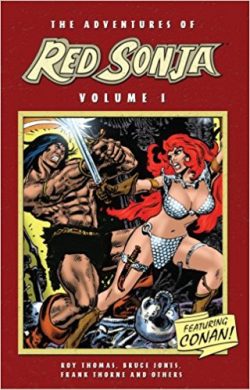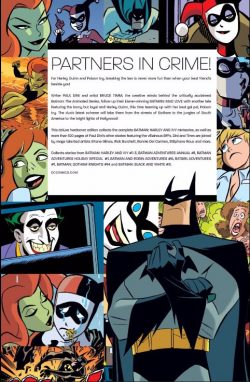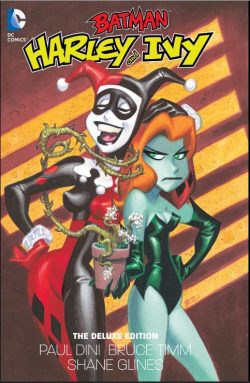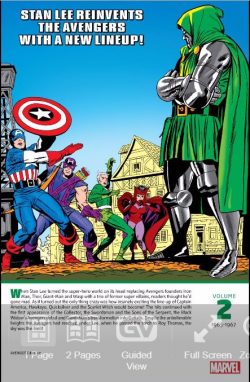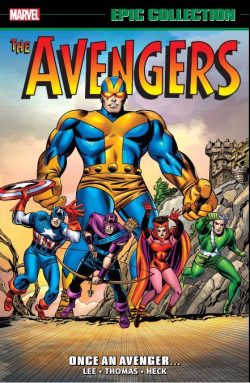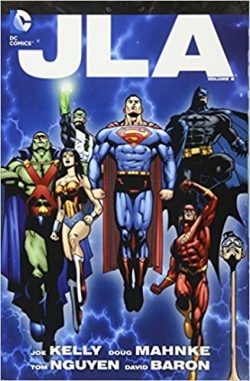
By Joe Kelly, Doug Mahnke, Yvel Guichet, Lewis La Rosa, Darryl Banks, Dietrich Smith & various (DC Comics)
ISBN: 978-1-4012-5136-9
Win’s Christmas Gift Recommendation: Blockbuster, No-Nonsense Entertainment… 8/10
When the Justice League of America – driving force and cornerstone of the Silver Age of Comics – was re-imagined and relaunched in 1997, the sheer bravura quality of the stories propelled the series back to the forefront of industry attention, making as many new fans as it recaptured old ones. The stories were smart, fast-paced, compelling, challengingly large-scale and drawn with effervescent vitality.
With JLA you could see on every page all the work undertaken to make it the best it could be…
The reinvigorated super-squad were a phenomenally hot property at this time, with creative teams coming aboard and moving on with startling rapidity. Writer Joe Kelly’s run on the World’s Greatest Superheroes has some notable moments for drama and action lovers, all contained in this Sixth Deluxe Trade Paperback and eBook compilation.
Contained herein are JLA #61-76 which comprise the majority of this fifth Deluxe Edition (available in hardback, paperback and eBook formats) and collectively spanning February 2002 to February 2003.
Illustrated by Doug Mahnke & Tom Nguyen, the wonderment kicks off with the stand-alone tale ‘Two-Minute Warning’, one of the best “day-in-the-life†type stories ever seen, blending sharp dialogue, spectacular art and a novel format to elevate it beyond the many other attempts to show what everyday means for such god-like beings…
Then 3-part disaster fable ‘Golden Perfect’ unfolds: a tale examining the nature of Truth itself. When Wonder Woman leads the team to the hidden kingdom of Jarhanpur to rescue a baby from a life of hereditary slavery, she encounters a despot whose philosophy counters her belief in objective or absolute truth.
The explosive dispute shatters her magical Golden Lasso of Hestia…
All too soon this defeat has astounding repercussions for the entire universe. The broken lasso has destroyed objective truth completely. What people believe becomes the only arbiter of Reality.
The moon is made of green cheese, the world is flat, Earth is the centre of the universe…
As it all unravels, a devastated Amazon Princess must find a way to reconcile her beliefs within the new Reality while the rest of the JLA battle desperately to keep the cosmos alive.
A dynamic end-of-everything tale that challenges the mind as well as stirring the blood, the patented Kelly one-liners, especially from Plastic Man, leaven the tension and heighten the enjoyment in this cracking little epic.
Changing pace and cracking more smiles, ‘Bouncing Baby Boy’ is a wistful, genuinely funny team-up of the mismatched Batman and Plastic Man. This small story looks at the sad side of the eternal clown (that would be Plas, not Bats…), seen through the “cold and emotionless†eyes of the Dark Knight, and provides a welcome change from the Big Stories that increasingly all super-team books comprise.
An extremely potent example of such follows, spanning issues # 66-76. ‘The Obsidian Age’ is an ambitious epic designed to redefine the JLA which begins with ‘The Destroyers Part 1′ as peculiar water-based events and phenomena indicate that Aquaman – believed killed in a recent catastrophe which seemingly eradicated Atlantis – is actually alive and trying to contact his JLA comrades.
When the team are subsequently attacked by an ancient mystical warrior they get their first clue that it’s not “somewhere†but “some whenâ€â€¦
‘The Destroyers Part 2’ finds the heroes recovering from a second attack by the terrifying Tezumak and native shaman Manitou Raven, whose coordinated manipulations bring the JLA into the ruins of ‘Stillborn Atlantis’ and all-out combat with the deranged Ocean Master. When Tempest (the all-grown-up Aqualad, now a powerful magical adept himself) and a conclave of mystic champions, including Zatanna, Faust and Doctors Occult and Fate, are called in to assess the deteriorating situation in the no-longer sunken city, the assembled paladins of science and magic realise that something truly terrible is about to be unleashed….
Renewed assaults from the past indicate another growing global crisis and when the JLA discover a hidden message from Aquaman, they voyage back 3000 years to discover an unsuspected era of Atlantean domination.
With Superman, Batman, Wonder Woman, Flash, Green Lantern, Martian Manhunter and Plastic Man gone, a stand-in team of heroes are appointed to guard the world, but the ancient mastermind behind the menace has also prepared a contemporary trap for the substitute JLA…
Illustrated by Yvel Guichet & Mark Propst, ‘New Blood’ features Zatanna and the Atom trying to stave off a concatenation of clearly unnatural natural disasters with the aid of Green Arrow, Captain Marvel, Firestorm, Jason Blood (with and without Etrigan the Demon), Hawkgirl, reformed villain and troubled soul Major Disaster, Nightwing and new find Faith. There’s even input and some hands-on help from the Justice Society of America uniting to form a desperate scratch-team woefully overmatched and under-trained…
Meanwhile and elsewhen, the strands of mystery are unravelled in ‘Revisionist History’ which finds the time-lost First Team in 1000BC, where an above-the-waves Atlantis leads a coalition of nations and super-warriors in a campaign to conquer the known world by sword and sorcery. This unrecorded episode of human history contravenes all known histories, and clandestine reconnaissance by the JLA reveals an enchantress named Gamemnae is behind the scheme.
However, her plans extend far beyond her own epoch and to that end she has kidnapped the 21st century water-breathing Atlanteans and enslaved their king Aquaman…
Fortunately, Gamemnae’s own team is far from united: Manitou Raven and his bride Dawn are deeply troubled by the venality of their allies and the obvious nobility of the Justice Leaguers…
Back in the future, focus returns to the new team in ‘Transition’ (with art again by Guichet & Propst) as the planet is ravaged by geological catastrophes and Gamemnae’s millennial booby-trap activates, designed to conquer the world of tomorrow by suborning its meta-human and mystic defenders…
In ‘History is Written By…’, Kelly, Mahnke & Nguyen reveal the JLA battling hopeless odds in ancient Atlantis whilst trying to liberate its enslaved, water-breathing, time-switched descendants, whilst in modern times ‘Last Call’ (Guichet & Propst) finds the replacement League faring badly against Gamemnae’s monstrous animated time-trap… until a ghostly message from the past enables them to turn the tide…
The tension mounts as ‘Obsidian’ follows the final tragic battle between the JLA and Gamemnae’s hyper-powered hit-squad The Ancients, revealing how her future assaults began even as Manitou finally succumbs to his conscience and changes sides.
‘Tragic Kingdom’ (by Mahnke, Guichet, Darryl Banks, Dietrich Smith and inkers Nguyen, Propst, Wayne Faucher & Sean Parsons) simultaneously provides the origin and final fall of the deadly Witch-Queen in a cataclysmic confrontation that bends times, breaks the barriers between life and death and costs one of the heroes everything…
In the aftermath the JLA gather to mourn one of their own who has fallen. ‘Picking up the Pieces’ (with art from Lewis LaRosa & Al Milgrom) sees the JLA conclude a 3000-year quest to restore their fallen comrade and re-jig their roster in the dread dire days following the adventure that has left them all forever changed…
By The Way: the action of Obsidian Age takes place immediately after the devastation of DC Crossover Event “Our Worlds At War†– wherein an alien doomsday device named Imperiex almost destroyed the planet – but there’s enough useful background and build-up in the chapters collected here to circumvent any possible confusion should that saga have passed you by…
Engaging, engrossing and especially entertaining, this is a superior superhero slugfest that will appeal to a lot of readers who thought the Fights ‘n’ Tights genre beyond or beneath them…
© 2002, 2003, 2015 DC Comics. All Rights Reserved.

